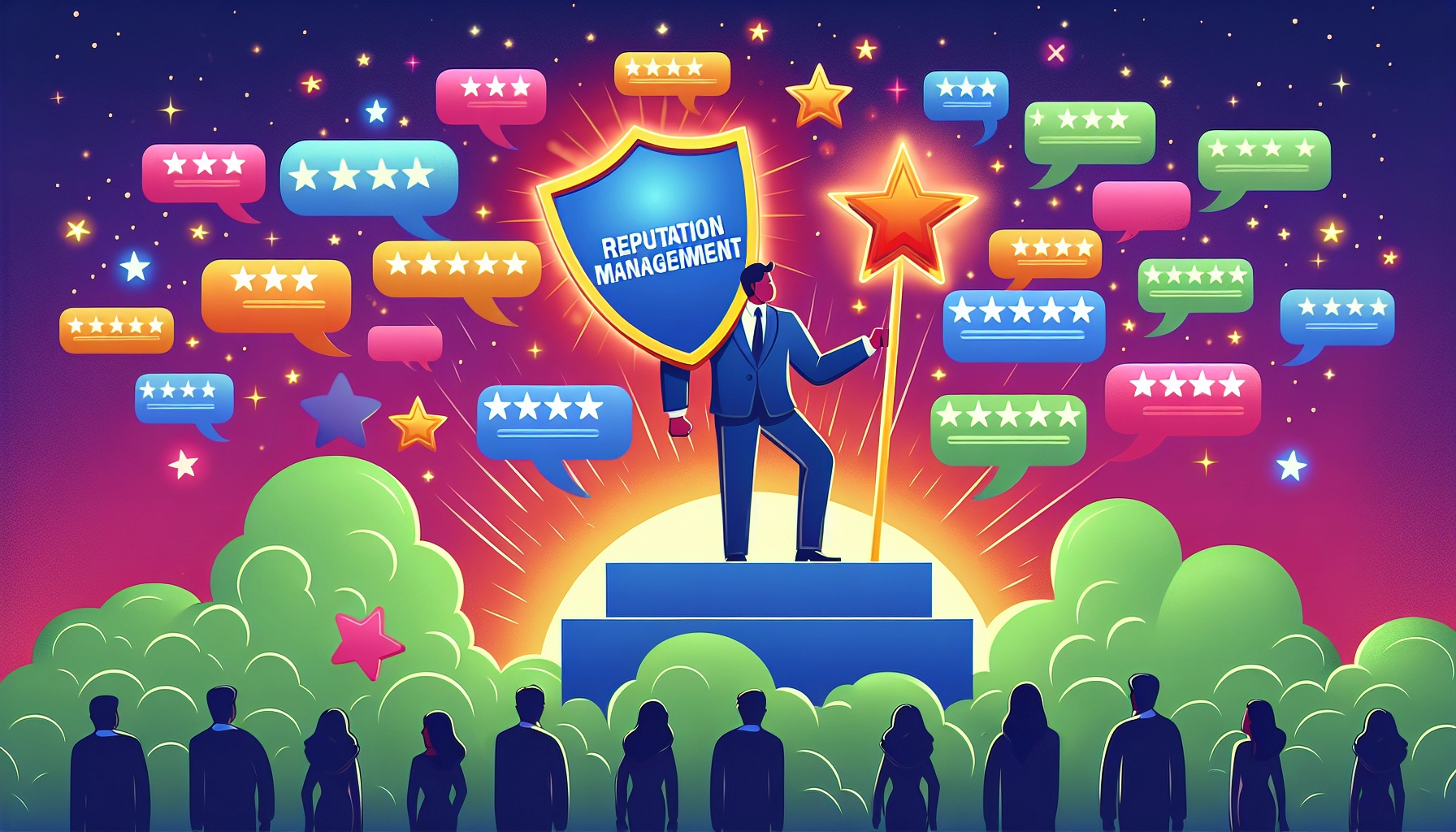Table of Contents[Hide][Show]
Brand reputation management of a company is essential for building trust and securing growth. One bad review can damage years of work. This article covers how to shape public perception positively, with strategies on digital presence, leadership influence, and crisis management.
Key Takeaways
Effective reputation management is essential for maintaining public perception, customer trust, and business success, particularly in a digital landscape influenced by online reviews.
Key elements of a successful corporate reputation management strategy include leadership influence, employee engagement, corporate social responsibility, and a strong digital presence.
Monitoring tools and proactive techniques, such as customer feedback and crisis management planning, are critical for maintaining and enhancing a company’s reputation.
Understanding Reputation Management

Reputation management shapes, monitors, and influences how the public perceives an organization. The role of reputation management is to showcase the good and help recover from crises. In a world where consumers read online reviews before buying, sound business reputation management is key. Strategic planning, customer trust, and sales all depend on a good reputation, which can take years to build but moments to destroy.
Not managing your online reputation can undo all your hard work. Online reputation management uses various strategies and tools to monitor, suppress, and enhance your online presence. It is crucial for countering harmful content, leveraging social listening tools, and maintaining a positive image to gain customer trust and loyalty. A positive reputation attracts top talent and strengthens relationships with investors and partners. A good reputation management strategy can set you apart from the competition online.
Definition of Reputation Management
Reputation management is the practice of influencing and controlling how others perceive a business or brand. It involves monitoring and managing online reviews, social media, and other digital platforms to maintain a positive image and reputation. Today, consumers heavily rely on online reviews and social media to make purchasing decisions, so effective reputation management is crucial. It helps businesses build trust, credibility, and loyalty with their customers, employees, and stakeholders. By actively managing their online reputation, companies can ensure that they are perceived positively, which can lead to increased customer satisfaction and business success.
Importance of Reputation Management
Reputation management is essential for businesses to succeed in today’s digital age. A positive online reputation can increase customer loyalty, retention, and advocacy, while a negative reputation can harm a business’s reputation and bottom line. With the rise of social media and online reviews, companies can no longer afford to ignore what is being said about them online. Effective reputation management helps businesses stay on top of their online presence, respond to negative feedback, and promote positive content. This proactive approach builds a solid and positive reputation and helps mitigate potential risks and crises. By investing in reputation management, businesses can enhance their brand image, attract new customers, and retain existing ones.
Benefits of Effective Reputation Management
Effective reputation management can bring numerous benefits to a business, including:
- Increased Customer Loyalty and Customer Retention Management: A positive reputation fosters customer trust and loyalty, leading to repeat business and long-term relationships.
- Improved Brand Image and Reputation: Consistently managing your reputation helps build a strong and positive brand image.
- Increased Revenue and Profitability: A good reputation can attract more customers, leading to higher sales and profitability.
- Better Employee Morale and Engagement: Employees are more likely to be engaged and motivated when they work for a company with a positive reputation.
- Increased Trust and Credibility: A well-managed reputation enhances trust and credibility with customers, employees, and stakeholders.
- Improved Online Visibility and Search Engine Rankings: Positive online reviews and content can improve your search engine rankings, making it easier for potential customers to find you.
- Enhanced Social Media Presence and Engagement: Active reputation management on social media can lead to better engagement and a stronger online community.
- Better Crisis Management and Response: A solid reputation management strategy allows for quicker and more effective responses to potential crises.
Key Elements of Reputation Management Strategy

An effective reputation management strategy has several core elements.
Leadership
Employee engagement
Corporate social responsibility
Digital presence
These all work together to keep a company’s reputation strong as the business grows and gets bigger and more complex.
Most reputation management is out of your control, but focusing on these will make a big difference to public opinion.
Leadership Influence
Leadership sets the tone for the whole organization and is key to reputation management. Good planning and strong leadership help navigate reputational risks and a culture of ethics and transparency. Without a positive brand reputation among leadership, you can’t have a good reputation overall.
A leader’s actions and tone can impact the company’s public face. For example, an open leader who promotes ethics can create a positive brand reputation, customer loyalty, and a competitive advantage.
Employee Engagement
Employee involvement is key to a good reputation management strategy. When employees know their part in the brand image, it improves the workplace culture, leading to higher satisfaction and a better perception of the company. Regular training sessions ensure employees are aligned with reputation management goals and updates.
Overall, employee engagement makes a company more reputable. By actively managing and asking for employee feedback, companies can improve customer experience, resolve customer issues better, and have a stronger social media presence. This is a key part of an effective reputation management strategy.
Corporate Social Responsibility
Doing socially responsible things can impact public opinion and brand loyalty. For example, Apple is committed to being carbon neutral by 2030 across the whole business, so it looks more sustainable. By using 100% recycled materials and renewable energy for manufacturing, it is trying to eliminate its carbon footprint, which has boosted its brand.
CSR helps businesses build stakeholder trust and a public image. Businesses that do CSR, like Apple, not only contribute to global sustainability but also have a stronger brand and customer loyalty.
Digital Presence
Having an online presence is key to visibility and reputation. The first step to improving a brand’s online presence is updating all owned channels to reflect current branding. Tools like Yext help with SEO by fixing business data inconsistencies across multiple sites. A company’s online presence comprises social media interactions, customer reviews, and news articles, all of which impact its reputation.
Online reputation management services are crucial in taking control of a business’s online presence. These services allow companies to present a positive image, protect their brand from negative content, and create customized strategies that adapt over time to changing algorithms. Online sentiment is a key KPI, and it is used to monitor reviews and social media to see what the public is saying about a brand. Brand mentions and share of voice metrics to see how a brand stacks up against competitors.
These elements make up the foundation of reputation management.
Tools for Monitoring Online Reputation

Monitoring brand mentions and online activity through tools is crucial to reputation management. These tools help you track and manage your reputation across all digital platforms so you can respond to positive and negative feedback in time. Effective online review management is crucial as it enables businesses to handle customer feedback on platforms like Google, Yelp, and Glassdoor. Don’t monitor social media, and you could get into big trouble.
Here are the tools:
Google Alerts
Google Alerts is a notification service that monitors the web for specific terms like your brand name. It notifies you of online brand mentions so you can respond to reviews in time.
This helps with reputation monitoring and managing online conversations with reputation management software.
Hootsuite
Monitor your social media and respond to customers in one place. Hootsuite consolidates social media management, presence, and feedback.
ReviewTrackers
ReviewTrackers collects and analyzes online reviews to help you manage your reputation. It pulls reviews from multiple sites to see customer sentiment and trends.
This tracks customer feedback across Google and Yelp for your overall reputation.
Brand24
Brand24 monitors brand mentions across the web to see how the public sees you. Online mentions volume and context-based insights.
Brand24 sentiment analysis measures customer emotions towards your brand.
Proactive Reputation Management Techniques

Reputation management is key to building a brand image and getting ahead of threats before they get out of control. A good corporate reputation management is a shield against crises and keeps business stable.
Here are how to do it:
Content Creation
Content controls what appears about a brand online. For example, Airbnb’s response to the pandemic was to show that it cared about its users by creating relevant and empathetic content. By consistently creating positive content, businesses can shape their brand and their online reputation.
User-generated content and a strong social media presence are key to content creation. Get customers to share their experiences and feedback online, and you’ll have a more authentic and positive brand experience. This proactive approach will keep you visible online and boost your overall reputation.
Customer Feedback
Customer feedback tells you what you’re doing right and what you’re doing wrong. Obtaining positive reviews and responding to feedback, especially negative reviews, is critical to your reputation and resolving customer issues. Engaging with customers through regular outreach and responding quickly shows you value their opinions.
Monitoring customer sentiment and feedback trends will pick up on minor issues before they become big problems. This proactive approach means you keep your positive online reputation and meet customer expectations.
Crisis Management Planning
Having a crisis management plan in place means you can respond quickly and deliberately to potential reputation threats. A consistent tone of voice is key when commenting to avoid appearing defensive and fake. A tone guide for a brand response should include language for crisis management and the brand tone.
Many businesses have had a crisis in the last five years. Not having a crisis communications plan can make things worse when the unexpected happens. By preparing for the potential and actively managing the response, often with the help of a reputation management company that implements public relations tactics and advanced SEO strategies, you can limit the damage and keep a strong reputation.
Develop a Tone Guide for Responding to Comments
Developing a tone guide for responding to comments is essential for businesses to maintain a consistent and positive online presence. A tone guide outlines the tone, voice, and language a business should use when responding to comments, reviews, and online feedback. It helps to ensure that all responses are consistent, professional, and aligned with the business’s brand values and mission. A tone guide should include guidelines for responding to positive, negative, and neutral comments and guidelines for using humor, empathy, and apology. With a clear tone guide, businesses can ensure that their responses are always on-brand and contribute positively to their online reputation.
Competitive Analysis and Brand Advocacy
Competitive analysis and brand advocacy are essential components of a reputation management strategy. Competitive analysis involves analyzing a business’s competitors to identify strengths, weaknesses, opportunities, and threats. This helps businesses understand the competitive landscape and develop strategies to differentiate themselves. On the other hand, brand advocacy involves identifying, engaging, and rewarding brand advocates who can help promote a business’s products or services. These advocates can be loyal customers, employees, or influencers who have a favorable view of the brand and are willing to share their experiences. Businesses can leverage competitive analysis and brand advocacy to enhance their reputation management strategy and build a strong, positive brand image.
Analyzing Your Competitors
Analyzing your competitors involves researching and analyzing their online presence, social media, and reputation management strategies. This can help businesses identify gaps and opportunities in the market and develop a competitive advantage. Some key metrics to analyze when researching competitors include:
- Online Reviews and Ratings: Assess the volume and sentiment of reviews on platforms like Google, Yelp, and industry-specific sites.
- Social Media Presence and Engagement: Evaluate the frequency and quality of posts, follower engagement, and overall social media strategy.
- Website Traffic and Search Engine Rankings: Use tools like Google Analytics and SEMrush to analyze website traffic and search engine performance.
- Content Marketing and Blogging Strategies: Review the type and frequency of content published and its engagement and reach.
- Customer Service and Support: Assess competitors’ responsiveness and quality of customer service.
- Reputation Management Strategies and Tactics: Identify competitors’ tools and techniques to manage their online reputation.
By analyzing competitors and developing a competitive advantage, businesses can improve their reputation management strategy and stay ahead of the competition. This proactive approach ensures they are always aware of industry trends and can adapt their strategies accordingly.
Case Studies of Successful Reputation Management

Examples are the best way to learn. Here are three companies that we believe got it right.
Starbucks’ Racial Bias Training
After a racial bias incident, Starbucks closed over 8,000 stores for a day of racial bias training. This training involved almost 200,000 partners and focused on creating a welcoming space and addressing systemic bias. They brought in civil rights experts to help develop the curriculum and emphasized learning from shared experiences to build a culture of inclusion and belonging.
Partners’ feedback was awareness and approach to customers are shifting from appearance to behavior.
By sharing the training materials, Starbucks is encouraging others to do the same. This addresses the short-term crisis and long-term brand.
Apple’s Environmental Initiatives
Apple’s big promises to go carbon neutral across its entire supply chain by 2030 have boosted its reputation. Using 100% recycled aluminum for many products and powering its facilities with 100% renewable energy has reduced its environmental footprint and set the bar high for sustainability. This is all part of Apple’s corporate responsibility and environmental leadership.
Apple’s focus on sustainability has boosted its reputation and connected it with consumers who care about ethics. This is in line with the values of a growing segment of consumers who prioritize sustainability, so brand loyalty increases, and Apple’s reputation goes up.
T-Mobile’s Customer Service Focus
T-Mobile prioritizes customer service with programs like Team of Experts, where customers have direct access to a dedicated team. This ensures that customer issues are resolved quickly and easily, improving customer experience and loyalty.
By making customer service a part of its brand, T-Mobile has carved out a niche in a crowded market.
Common Pitfalls in Reputation Management
Bad reputation management can lead to big backlash, loss of customer trust, and bad press. Not dealing with negative feedback can also lead to bad business.
Ignoring Negative Reviews
Don’t ignore negative reviews; you’ll avoid reputation damage and customer mistrust. Effective review management is essential for monitoring and responding to customer feedback across multiple review sites. Being proactive and responsive is key to a good reputation. Starbucks responded to public outcry by doing racial bias training after the racial profiling incident.
Lack of Transparency
Not being transparent can damage customer trust and reputation. Businesses that don’t communicate can be seen as secretive, which can damage customer loyalty.
Being transparent with customer feedback is key to trust and a positive reputation.
Inconsistent Messaging
Mixed messages confuse customers and kill credibility. Contradictory messages kill your brand credibility and brand.
Consistency is key to being clear and looking professional.
Implementing a Reputation Management Plan
Reputation management involves research, audits, strategies, and training. Every business is different and needs bespoke solutions.
Research and Audit
Research is the starting point for reputation management. It helps you understand where you are now. Use good reputation management tools to do an audit, which allows you to dig deeper into your business.
An audit will show you trends and industry changes that can help or hurt your brand. This is especially crucial for local businesses as online reviews significantly impact consumer behavior. Building trust and credibility through positive reviews is essential for attracting customers and maintaining a positive image.
Develop Strategies
Know your brand and business before you create reputation management strategies. A brand management strategy should have goals, tools, and timing.
Reporting and adjusting based on data will improve reputation management strategies.
Communicate and Train
Sharing the plan makes employees accountable. Reputation strategy meetings should include sharing the plan and making employees accountable. Training keeps the team in line with business changes to reputation.
Everybody is involved in reputation by aligning their work with it.
Measuring Reputation Management Success
Many metrics and KPIs measure reputation management. Your reputation management plan needs to be reviewed and updated as things change.
Key Performance Indicators (KPIs)
You need to measure reputation management with both numbers and words. NPS is a KPI that measures customer loyalty.
Customer Sentiment Analysis
Sentiment can be positive, negative, or neutral. Machine learning helps with sentiment by analyzing patterns in customer feedback (surveys and social media are key).
Regular Reporting
Reporting is critical to ongoing reputation management, performance, and areas for improvement. KPIs are customer feedback, sentiment, and brand mentions. Staying on top of feedback can give you data-driven insights to make changes to improve the customer experience and your company’s reputation.
Summary
Utilizing a comprehensive strategy to preserve a robust corporate reputation is essential. Your plan should encompass elements such as the impact of leadership, active participation of employees, commitment to social responsibility, and a significant online footprint. Companies can preemptively tackle potential risks by employing monitoring instruments and forward-thinking strategies. Examining real-world examples from renowned businesses like Starbucks, Apple, and T-Mobile provides critical insights into adept reputation management. Steering clear of typical missteps and crafting an informed plan for managing reputation are vital components in securing enduring achievement and grit. If this task seems too large, reach out to one of the Top Digital Marketing Companies to help you tackle this challenge.
Frequently Asked Questions
What is reputation management?
Reputation management is the practice of shaping, monitoring, and influencing public perception of an organization. It is crucial for maintaining a positive image and proactively addressing potential issues.
Why is employee engagement important in reputation management?
In reputation management, the importance of employee engagement must be balanced. It promotes a positive workplace culture, subsequently improving the public’s views and feelings about the company. Employees who are actively engaged become proponents of their brand, strengthening its good standing in return.
How can Google Alerts help with reputation management?
Google Alerts is a valuable tool for reputation management. It enables businesses to monitor online mentions of their brand, providing timely insights that can help address issues proactively.
What are the benefits of corporate social responsibility (CSR)?
Adopting CSR measures enhances a business’s reputation in the public eye, strengthens bonds with stakeholders, and bolsters brand devotion.
Why is it important to respond to customer feedback?
Responding to customer feedback is essential for maintaining your company’s reputation and effectively addressing customer concerns.
 What Is A Press Release: Understanding Its Purpose and Benefits
What Is A Press Release: Understanding Its Purpose and Benefits